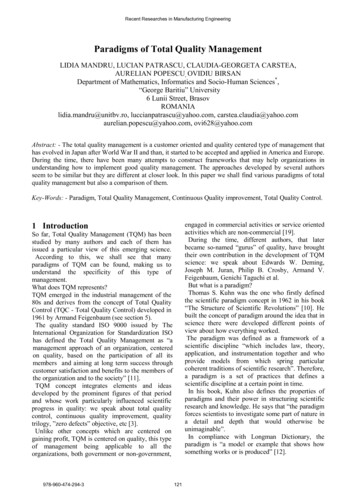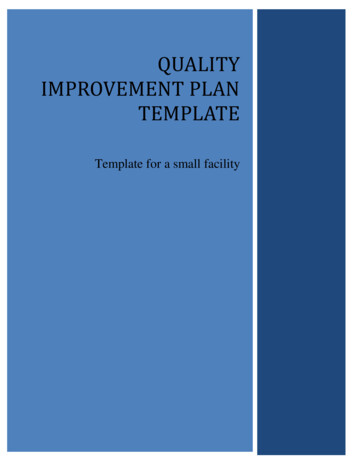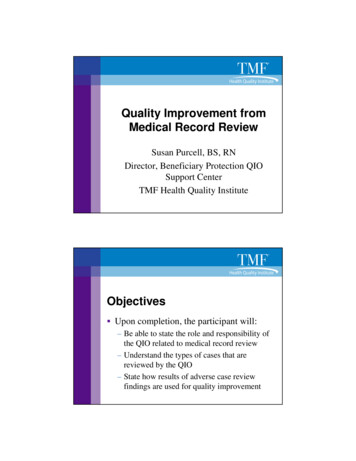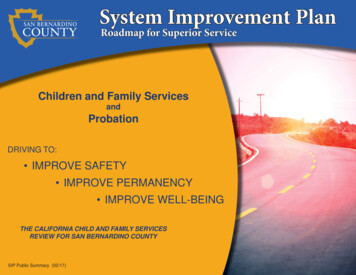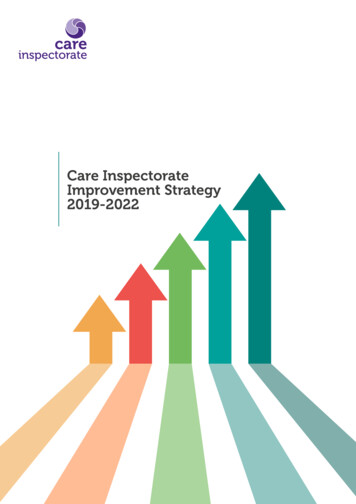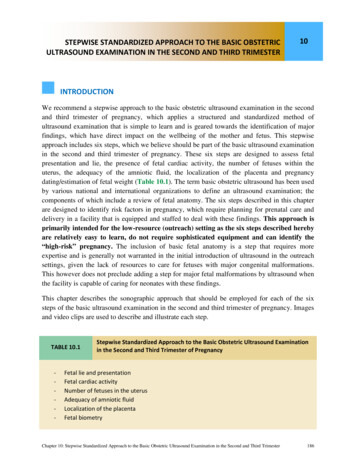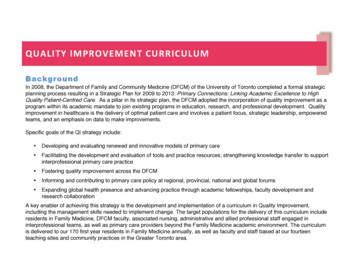
Transcription
QUALITY IMPROVEMENT CURRICULUMBackgroundIn 2008, the Department of Family and Community Medicine (DFCM) of the University of Toronto completed a formal strategicplanning process resulting in a Strategic Plan for 2009 to 2013: Primary Connections: Linking Academic Excellence to HighQuality Patient-Centred Care. As a pillar in its strategic plan, the DFCM adopted the incorporation of quality improvement as aprogram within its academic mandate to join existing programs in education, research, and professional development. Qualityimprovement in healthcare is the delivery of optimal patient care and involves a patient focus, strategic leadership, empoweredteams, and an emphasis on data to make improvements.Specific goals of the QI strategy include: Developing and evaluating renewed and innovative models of primary care Facilitating the development and evaluation of tools and practice resources; strengthening knowledge transfer to supportinterprofessional primary care practice Fostering quality improvement across the DFCM Informing and contributing to primary care policy at regional, provincial, national and global forums Expanding global health presence and advancing practice through academic fellowships, faculty development andresearch collaborationA key enabler of achieving this strategy is the development and implementation of a curriculum in Quality Improvement,including the management skills needed to implement change. The target populations for the delivery of this curriculum includeresidents in Family Medicine, DFCM faculty, associated nursing, administrative and allied professional staff engaged ininterprofessional teams, as well as primary care providers beyond the Family Medicine academic environment. The curriculumis delivered to our 170 first year residents in Family Medicine annually, as well as faculty and staff based at our fourteenteaching sites and community practices in the Greater Toronto area.
A. VisionAdvancing Family Medicine through leadership, accountability, performance and quality improvement.B. PhilosophyImage WithheldThe Chinese symbol for “qi” (“chi”pronounced “chee”) means “life force.” Itreflects our philosophy that for a familyphysician, the essence of our medical lifeis the quality of care we provide to ourpopulation of patients – hence QIfiguratively is our “essence ofprofessional life.”C. MissionThis curriculum will prepare family physicians and other primary providers for practice in an environmental culture of continuousquality improvement and accountability through: 1Utilizing the behaviours of the reflective practitioner to identify opportunities for improvement in their practiceenvironments,Teaching the skills of continuous quality improvement and applying them in a project practicum,Introducing management concepts that they will use in their roles as leaders of primary care teams.Grounding the program in the Principles of Family Medicine and the “Triple C Curriculum” - incorporating the corecompetencies of Family Medicine as outlined by the College of Family Physicians of Canada1http://cfpc.ca/Triple C/2
D. Core 4-Day Teaching ProgramModulesLearning ObjectivesPre-course Preparation Complete a detailed, structured practice profile to identify perceived opportunities for improvement, aswell as uncover opportunities that were previously not perceived.Program Overview Define and clarify the CanMEDS FM (Family Medicine) roles and competencies addressed in thiscurriculum in Quality Improvement.Describe the QI program elements and integrated leadership and manager themesDefine your professional responsibilities during the program and for the project practicum.Begin to identify opportunities in primary care at multiple system levels that support QIimplementation.Recognize how change can have a positive impact on your patients, your practice and yourcommunity.Distinguish and contrast QI with other quality-related initiatives. Quality Assurance/Research/Knowledge Translation Integrate QA and QI initiativesDevelop your role as a health care leader.Distinguish the characteristics of complex adaptive systems, as they relate to health care.Recognize the leadership competencies you will need as a leader in primary care.Describe and evaluate your practice.Identify perceived opportunities for improvement in your practice.Apply the QI Framework and QA approaches to identify previously unrecognized quality improvementopportunities in your practice.Prioritize opportunities for improvementSelect a QI project at the system level to initiate your QI journeyDistinguish the components of Demingʼs Theory of Profound KnowledgeDevelop a “systems thinking” approachDescribe the Model for Improvement.Define teamDifferentiate stages of team developmentIdentify stakeholders in your QI initiative.Perform a stakeholder analysis.Strategize engagement of stakeholders.Describe the roles needed on your QI team.Rationale for QualityImprovement in Primary Care Leadership in Health CareChoosing Opportunities forChangeModel for ImprovementOverviewQI Team Form - Start-up 3
ModulesStructuring the ImprovementProcess Tools and AnalysisChange ManagementLearning Objectives Testing A Change IdeaData Collection Select your QI TeamPrepare to answer the fundamental questions in the Model for ImprovementDevelop an Aim Statement for practice improvement, which defines positive change.Establish measures of improvement: outcome, process, and balance. (System Level)Define benchmarks and targetsDevelop change ideas to testUse change concepts to brainstorm previously unperceived change ideas.Initiate improvement using Process Tools.Choose and use appropriate process tools: Process Map Cause & Effect Diagram Force Field AnalysisUse process tools to prioritize and select change ideas.Use process tools throughout a QI initiative.Describe some challenges of implementing change.Explore why physicians resist changeUse the Trans-theoretical Model to support stakeholdersʼ change.Manage the scope and pace of change across levels of care.Spread and implement change effectively in your practice through QI.Utilize the 5 Whys techniqueSelect a change idea.Differentiate the four steps of the PDSA Cycle: Plan, Do, Study, Act.Prepare for a test of change using the rapid PDSA cycle for improvement. Recall aim, measures and change ideas State change idea to test first Predict outcome Use Process Tools to define test of changeIdentify indicators and data needed to track testPrepare to Act in the PDSA rapid cycle for improvementSpread and implement changes in practiceUse an iterative approach of rapid cycles of improvement to develop and implement changeSelect an indicator for your PDSA test of change.Outline a 4 step Data Collection Plan.4
ModulesLearning ObjectivesQI Team Storm – ConflictResolution Differentiate between continuous and categorical data. Develop data collection formsUse the benefits of contrasting opinion.Recognize different conflict-resolution strategies.Develop a collaborative approach to conflict resolution. Image WithheldFor information about the Canadianresidency, the Triple C Curriculumand CanMEDS FM go towww.cfpc.ca/Triple CData Analysis The DFCM QI curriculum iscentered in Family Medicine andaddresses many aspects of allthe roles of CanMEDS FamilyMedicine, including up to 75% ofall of the enablingcompetencies.Describe four measurement tools used in Quality Improvement: Run Chart Frequency Plot Bar Chart Pareto DiagramSelect and use different tools to analyze continuous and categorical data.Analyze run charts to assess degree of variability, or stability, of the system under reviewIdentify next action steps.5
ModulesLearning ObjectivesQI Team Norm – Negotiations Describe the nature of negotiations in QI teams.Develop negotiation strategies.Respond when negotiations are not going well.QI Team Perform –Optimizing Team FunctionQI Team Transform - AKnowledge Creating Team Make meetings work! Use qualitative feedback tools to increase your teamʼs innovation and productivityFacilitate brainstorming.Create affinity diagrams.Run focus groups.Use nominal group processes. Use a consensus pyramid.Apply a chronic disease model to your practice environmentMatch a defined population by its need, with your resourcesRecognize that chronic disease management will be a high proportion of your workDevelop a systems framework to address the complexity of CDM and stratify populations with chronicdiseases in defining their needsIdentify opportunities for improvement, to launch the Model for Improvement for improving the healthof these sub-populationsChronic Disease Management QI Team Adjourn – Celebrateand ShareSummation and Next Steps –Project Practicum Apply the Model for Improvement to manage patients with chronic diseaseObtain universal patient consent to join a in Quality Improvement practice.Celebrate your QI accomplishments.Share what you have learned.Begin the practical application of QI in your practice6
E. Core Concepts, Skills and ToolF. Teaching and Learning Activities (General)LecturePartner and Table discussionsRole PlayProblem SolvingProjects (see below)7
G. Project Practicum Develop a project idea through completion of a worksheet on opportunities for change from project workbookDetermine best practices through critically appraising an appropriate literature review and/or a structuredconsultation with knowledge experts.Define project scope and goalsWith a stakeholder analysis, review team roles and skills to ensure those necessary are represented on the projectteamUse process tools to analyze relevant activities, present and proposed.Determine types and sources of data available to meet goalsStructure an improvementDevelop a data planRecord and report on meetings using PDSA worksheetsTest one or more change ideas to achieve your aim.Report with submission of materials as outlined in project workbook, design posterCompletion Date In Six MonthsH. Feedback and EvaluationCompletion of QI WorkbookSubmit progress as outlined in project workbook at 2 months, 4 months, and final report and poster at six months.To Bring This Program To You Contact:Quality Improvement ProgramDepartment of Family and Community MedicineUniversity of Toronto600 University Ave.,Toronto, Ontario Canada M5G 1V7Phone 416-946-5938, Fax 416-978-3912Program Director Philip Ellisonphil.ellison@utoronto.caExecutive Director MaryKay Whittaker marykay.whittaker@utoronto.caAdministrative Managermargaret.bucknam@utoronto.ca8
University of Toronto 600 University Ave., Toronto, Ontario Canada M5G 1V7 Phone 416-946-5938, Fax 416-978-3912 Program Director Philip Ellison phil.ellison@utoronto.ca Executive Director MaryKay Whittaker marykay.whittaker@utoronto.ca Administrative Manager margaret.bucknam@utoronto.ca





